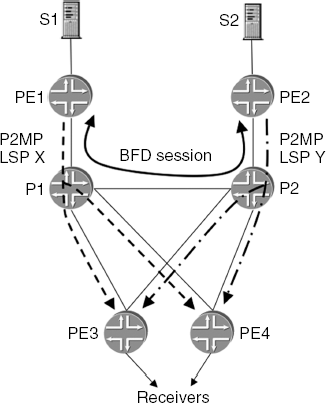6.7. INGRESS REDUNDANCY FOR P2MP LSPs
In some deployments, redundant ingress PEs are used for resilience. This is illustrated in Figure 6.9. PE1 is the ingress for P2MP LSP X and PE2 is the ingress for P2MP LSP Y. The paths of the two P2MP LSPs do not have any links or nodes in common. Sources S1 and S2 send identical traffic to PE1 and PE2, respectively. One option is for each ingress router to always send the traffic onto its respective P2MP LSP. However, this wastes bandwidth as the data is being sent into the network twice and may be problematic for the receivers as they will receive duplicate copies of the data.
Figure 6.9. Ingress PE redundancy for P2MP LSPs

Some implementations avoid this problem by having a scheme to choose a designated forwarder for the traffic. In order for each PE to detect that the other is up, a BFD session is created over a point-to-point LSP between the two PEs. Typically, there would be a preexisting point-to-point LSP between the PEs anyway for the purpose of carrying unicast traffic, which could be used to carry the BFD session. While both PEs are up, the designated forwarder is the one with the lower IP address. Let us suppose this is PE1. As a result, PE2 does not forward traffic into the P2MP LSP, unless it detects through BFD timeout that PE1 has gone down. In that case, it takes over and begins to forward traffic into the P2MP LSP.
The ...
Get MPLS-Enabled Applications: Emerging Developments and New Technologies now with the O’Reilly learning platform.
O’Reilly members experience books, live events, courses curated by job role, and more from O’Reilly and nearly 200 top publishers.

